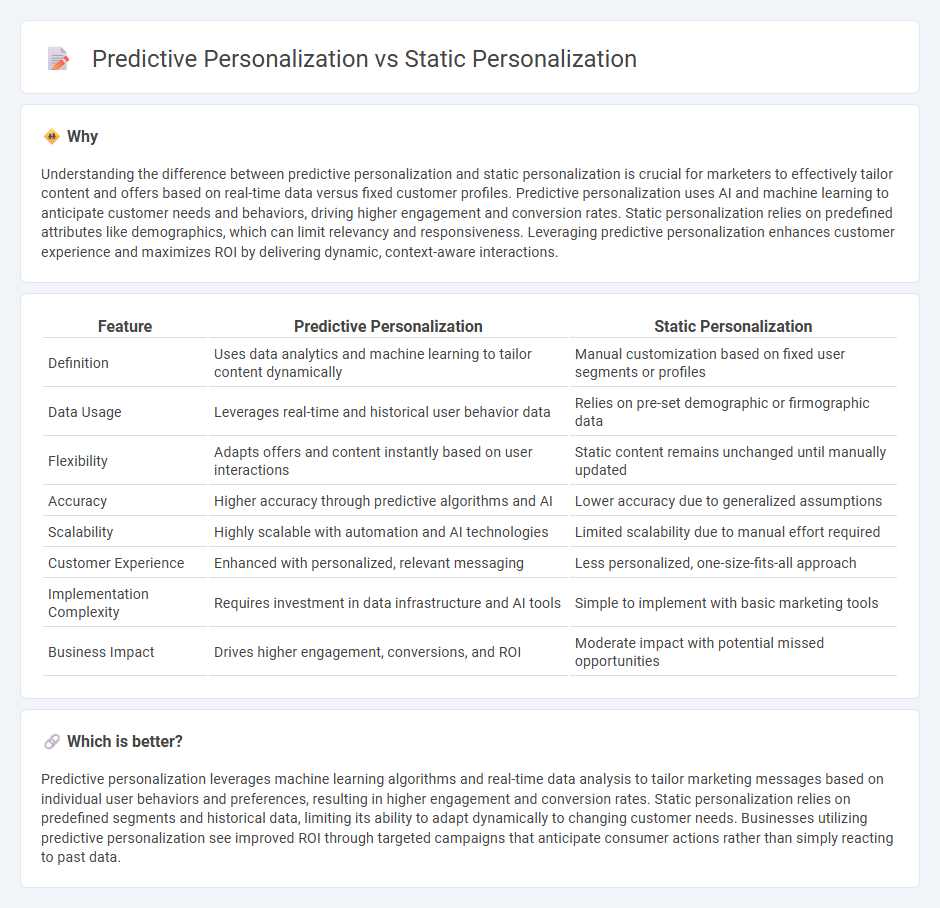
Predictive personalization leverages data analytics and machine learning algorithms to tailor marketing content dynamically based on individual customer behaviors and preferences, enhancing engagement and conversion rates. Static personalization relies on predetermined criteria such as demographics or past purchases, offering limited customization and often missing evolving consumer needs. Explore how predictive personalization transforms customer experiences and drives marketing success.
Why it is important
Understanding the difference between predictive personalization and static personalization is crucial for marketers to effectively tailor content and offers based on real-time data versus fixed customer profiles. Predictive personalization uses AI and machine learning to anticipate customer needs and behaviors, driving higher engagement and conversion rates. Static personalization relies on predefined attributes like demographics, which can limit relevancy and responsiveness. Leveraging predictive personalization enhances customer experience and maximizes ROI by delivering dynamic, context-aware interactions.
Comparison Table
| Feature | Predictive Personalization | Static Personalization |
|---|---|---|
| Definition | Uses data analytics and machine learning to tailor content dynamically | Manual customization based on fixed user segments or profiles |
| Data Usage | Leverages real-time and historical user behavior data | Relies on pre-set demographic or firmographic data |
| Flexibility | Adapts offers and content instantly based on user interactions | Static content remains unchanged until manually updated |
| Accuracy | Higher accuracy through predictive algorithms and AI | Lower accuracy due to generalized assumptions |
| Scalability | Highly scalable with automation and AI technologies | Limited scalability due to manual effort required |
| Customer Experience | Enhanced with personalized, relevant messaging | Less personalized, one-size-fits-all approach |
| Implementation Complexity | Requires investment in data infrastructure and AI tools | Simple to implement with basic marketing tools |
| Business Impact | Drives higher engagement, conversions, and ROI | Moderate impact with potential missed opportunities |
Which is better?
Predictive personalization leverages machine learning algorithms and real-time data analysis to tailor marketing messages based on individual user behaviors and preferences, resulting in higher engagement and conversion rates. Static personalization relies on predefined segments and historical data, limiting its ability to adapt dynamically to changing customer needs. Businesses utilizing predictive personalization see improved ROI through targeted campaigns that anticipate consumer actions rather than simply reacting to past data.
Connection
Predictive personalization and static personalization are connected through their common goal of tailoring marketing messages to individual customers. Predictive personalization uses data analysis and machine learning algorithms to anticipate customer preferences and deliver dynamic content, while static personalization relies on predefined customer segments and fixed attributes. Integrating both approaches enhances targeted marketing strategies by combining real-time insights with foundational customer data for improved engagement and conversion rates.
Key Terms
Segmentation
Static personalization relies on predefined segments based on demographic and behavioral attributes, offering limited adaptability to changing user preferences. Predictive personalization uses machine learning algorithms to analyze real-time data, enabling dynamic segmentation that anticipates user needs and enhances engagement. Explore how predictive segmentation can revolutionize your marketing strategies by delivering more precise and timely personalized experiences.
Machine Learning
Static personalization relies on predefined rules and historical data to customize user experiences, often resulting in limited adaptability. Predictive personalization employs machine learning algorithms to analyze real-time behavior and forecast user preferences, enabling dynamic and highly relevant content delivery. Explore how machine learning transforms user engagement through predictive personalization.
Real-time Data
Static personalization relies on predefined user attributes and historical data to tailor content, offering a fixed user experience without adapting to immediate behavior. Predictive personalization leverages real-time data analytics and machine learning algorithms to anticipate user needs dynamically, enhancing engagement and conversion rates. Explore detailed insights on how real-time data transforms personalization strategies.
Source and External Links
Personalizing static sites using Kontent.ai and Pardot - Static personalization involves serving different content segments to various website visitors, typically requiring visitor data collection and rule-based segmentation to tailor content, often aided by tools like Salesforce Pardot for tracking and CRM integration.
From static to living interfaces: the evolution of personalization - Static personalization is the initial step where user preferences are applied at specific navigation points, maintaining consistency while transitioning towards dynamic, adaptive user experiences by updating profiles as users interact with content.
Personalization & Engagement: The Power of Hyper-Targeted Marketing - Static personalization relies on manual rules and templates, contrasting with AI-driven dynamic personalization that adapts in real time by processing user behavior to create fluid and context-aware experiences.
 dowidth.com
dowidth.com